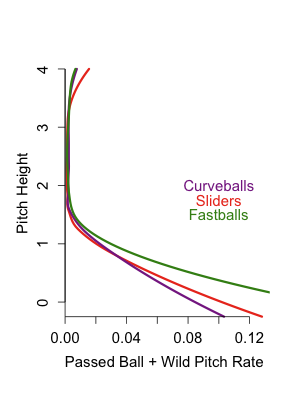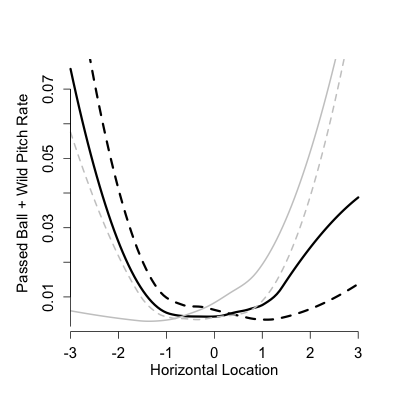
| F/X Visualizations | December 04, 2009 |
Two weeks ago I introduced the idea of evaluating catcher's ability to prevent wild pitches and passed balls using the pitchf/x data. In that post I presented the idea and some preliminary findings.
Here I will present that evaluation. I constructed a model which gives the probability a pitch gets passed the catcher based on the pitch type, its location and the handedness of the batter/pitcher.
Before presenting how the catchers ranked under this model I will address some questions posed by commenters. First MGL:
Obviously most WP are pitches thrown in the dirt (I assume), and almost no PB are pitches in the dirt. That is important. Also, a fastball in the dirt is extremely difficult to catch. A slider is somewhat difficult and a curve ball is not all that difficult
The pitchf/x system gives pz, the height of a pitch as it crossed the plate. Negative values are possible, those pitches have hit the ground before they got to the plate, and if they could keep going down they would have ended up somewhere below the plate. Other pitches that are very low, but positive, when they cross the plate will end up in the dirt. If one were not lazy, like me, he could go back and calculate, roughly, if a pitch will have a negative height before it reaches the catcher. I did not do this, but just looked at the reported height as it crosses the plate. Anyway here is how sliders, curves and fastballs vary for PB+WP% by height.

It looks like MGL is correct low fastballs are much more likley to get by the cacher than low sliders or curves.
Now Guy:
Dave: You mention that catchers have more trouble with inside pitches. While that could be the presence of the hitter, it might also be that catchers have more trouble with balls on the glove side of their body. What does this pattern look like for RHP vs. LHB? And with LHPs?
Another great question. In my post I showed just the RHB/RHP image and inferred that since inside pitches were harder because of the batter, but without looking at the other ones it could be for other reasons.
Here is the rate by horizontal location. RHBs are in black, LHBs in gray. RHPs are solid and LHPs dotted.

First off since the black lines both increase sharply to the left of the graph and gray lines to the right, we have that inside pitches do in fact have the highest passed ball rates regardless of handedness of the pitcher or batter. Outside pitches get by the catcher more often in same-handed at-bats than opposite for some reason. [On the left sided the dotted gray line (LHB/LHP) above the solid gray (LHB/RHP) and on the right side the solid black line (RHB/RHP) is above the dotted black (RHB/LHP) ].
Ok now for the catcher evaluations. I went through each pitch a catcher saw with men on base and based on its location and pitch type gave it a probability that the average catcher lets it by. First off there is considerable variation in expected number of passed balls/wild pitches a given catcher sees. Over the course of the pitchf/x era (part of 2007 and all of 2008 and 2009) Gregg Zaun saw the toughest pitches, with an expected 10.2 getting by him for every 1000 pitches with men on base. On the other hand Jason Varitek saw the easiest pitches. The average catcher would only let 7.1 by per 1000 pitches with men on. So it seems the model does project some variation.
It turns out that both these catchers do a good job. Here are the leaders and laggards in difference between expected and actual WP+PBs in the pitchf/x era. Each one is worth 0.28 runs, so over about two and a half years the best catcher is only about one win over average and the worst only one win below average.
+--------------------+-------+ | Catcher WP+PB - expected | +--------------------+-------+ | Zaun, Gregg | -32.1 | | Suzuki, Kurt | -32.1 | | Ruiz, Carlos | -30.2 | | Molina, Yadier | -26.7 | | McCann, Brian | -24.5 | | Varitek, Jason | -23.7 | | Coste, Chris | -21.1 | | Quintero, Humberto | -18.1 | | Barajas, Rod | -14.8 | | Torrealba, Yorvit | -14.7 | +--------------------+-------+ | Iannetta, Chris | 11.4 | | Montero, Miguel | 11.7 | | Doumit, Ryan | 14.4 | | Snyder, Chris | 14.7 | | Burke, Jamie | 15.4 | | Navarro, Dioner | 15.7 | | Molina, Jose | 16.5 | | Shoppach, Kelly | 16.7 | | Olivo, Miguel | 29.9 | | Molina, Bengie | 30.2 | | Posada, Jorge | 36.4 | +--------------------+-------+
Comments
Since there are some big differences in PT between the catchers, why not show the differences as percents of the expected? Also I'd split the WP's from the PB's since only the PB's should be primarily the fault of the catcher (unless of course he's catching Wakefield).
Posted by: James M. at December 4, 2009 12:07 PM
James,
To your second point. The WP/PB classification is a subjective distinction based on the scorer, the point of this article is to remove this. By assigning a probability that any pitch gets by the average catcher I can assign blame to catchers for missing easy ones and reward them for getting hard ones.
To your first point, here are the top 10 catchers (who have seen at least 5000 pitches with runners on) with WP/PB-expected per 1000 pitches.
-3.9 Coste
-3.9 Quintero
-3.8 Zaun
-3.6 Wieters
-3.0 Redmond
-2.9 Towles
-2.8 Ruiz
-2.5 Moeller
-2.4 Ausmus
-2.3 Teagarden
and the laggards:
1.7 Snyder
1.7 Montero
1.8 Doumit
2.0 Barrett
2.2 Molina, Bengie
2.2 Shoppach
2.5 Molina, Jose
2.7 Inge
3.9 Olivo
4.9 Posada
Posted by: Dave Allen at December 4, 2009 12:27 PM
The 2nd makes more sense than the first adding well-regarded part-timer Ausmus and highlighting the durable Suzuki's accumulation of counting stats due to his time played as he drops off the rate list.
Also interesting is how not all Molinas are interchangeable as Y is about as far from his brothers as you could get.
Posted by: Gilbert at December 4, 2009 3:53 PM
Where does AL gold glover Mauer land?
Posted by: Coop at December 7, 2009 5:26 AM
Coop,
Mauer is just barely worse than expected. He let an extra three pitches passed compared to expected, which works out to 0.29 more than expected per 1000 pitches and less than one run worse than average over the pitchf/x era (2.5 years).
Posted by: Dave Allen at December 7, 2009 6:49 AM
Dave:
Thanks for getting back to my question. Clearly, inside pitches are toughest for catchers to handle, which makes sense. You note that "Outside pitches get by the catcher more often in same-handed at-bats than opposite for some reason." I think this also makes sense: in same-handed at bats, an outside pitch is tailing away from the catcher; in opposite-handed at bats, however, an outside pitch (e.g. from a RHP to a LHP) is breaking toward the catcher. You can also see this pattern on inside pitches: an inside pitch to a RHB is harder to handle when it comes from a LHP, because it's breaking away from the catcher.
However, there's an interesting disparity in the data, which is that catchers have more trouble handling the tailing outside pitch with a LHH than with a RHH. I wonder if this pattern might help explain the old mystery of no LH catchers. If catchers have trouble handling these pitches on their glove side, then a LH catcher would be at a disadvantage because RHP/RHH matchups are more than 4x as common as LHP/LHH matchups. I'm also assuming that pitchers throw a lot more balls over a foot outside than they do a foot inside, and so handling the outside pitch is more important.
Posted by: Guy at December 12, 2009 9:04 PM